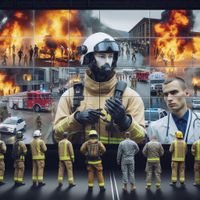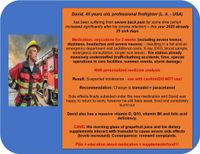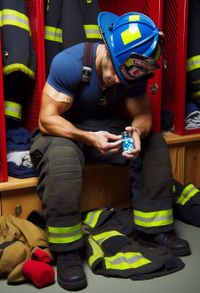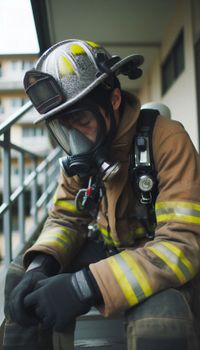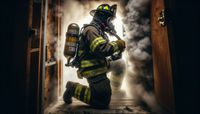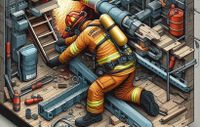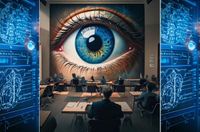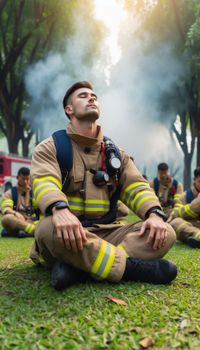Scenario Training in AR and Real Life
(Potential) Key Groups for Training
To elevate safety and crisis management to an optimal level, it is crucial that various stakeholder groups undergo realistic and intensive training scenarios.
1. Firefighters
- Tasks and Focus: As first responders to fires and technical operations, they often serve as the first line of defense against escalating emergencies. Training in firefighting, tactical rescue and handling unpredictable hazards.
2. Security Forces in Critical Infrastructure
- Tasks and Focus: Protecting and securing essential facilities such as power plants, waterworks or transportation systems. Preparing for disruptions and threats that could jeopardize the population's supply security.
3. Police Officers
- Tasks and Focus: Managing extreme situations, including hazard control in areas with dangerous substances and confined environments. Specialized training in crisis management, conflict resolution and protection against hazardous materials.
4. Emergency Medical Personnel and Paramedics
- Tasks and Focus: Also among the first on-site, they carry out life-saving measures and support those in acute emergencies. Quick decision-making, effective first aid techniques and operating under physically and psychologically challenging conditions.
5. Military Units
- Tasks and Focus: Supporting rescue and evacuation missions in extremely dangerous environments. Crisis operation planning, civilian aid and collaboration with other stakeholders.
6. Crisis Managers and Coordinators
- Tasks and Focus: Leading and organizing emergency personnel during crises and disasters. Rapid and informed decision-making, strategic planning and optimized communication between emergency teams.
7. Disaster Relief Forces
- Tasks and Focus: Managing large-scale emergencies such as floods, earthquakes or chemical accidents. Logistics management, risk analysis and coordinated operations in highly complex scenarios.
8. Volunteer Helpers and Civil Protection Organizations
- Tasks and Focus: Supporting professional teams during disasters and emergencies. Training for effective collaboration and swift integration into professional workflows.
Why Are Joint Training Scenarios Essential?
The integration of these various stakeholder groups into realistic training scenarios offers several advantages:
- Increased Effectiveness: Practical exercises strengthen skills and optimize coordination between teams.
- Improved Collaboration: Joint training fosters understanding of the different roles and responsibilities within each group (and its members).
- Future-Proofing: Balanced preparation for both predictable and unpredictable scenarios enhances long-term resilience and safety for the population.
By involving the various proposed groups in similar training scenarios, we can improve their skills and preparedness for extreme emergency situations, thereby ensuring the safety and well-being of the population.
Examples of (Possible) Training Scenarios
Training in Crowd Management with Augmented Reality (AR) – Simulation of Varying Crowd Sizes
1. Conducting Real-Time Simulations
- With AR, numerous dynamic scenarios can be created where the number of people in a building constantly changes. This allows firefighters (or other emergency responders) to practice a variety of situations, ranging from low occupancy to completely overcrowded buildings.
- AR could also integrate interactive elements, such as moving avatars that mimic the behavior and movements of real people. This could help to precisely simulate realistic crowd dynamics and movements.
2. Optimizing Resource Planning
AR systems could provide firefighters and police forces with real-time data on the number of people in a building. This information is crucial for optimizing operational planning, such as allocating rescue teams or adjusting strategies based on population density.
By simulating crowds, firefighters and emergency responders could test and refine strategies for positioning resources like firefighting teams and evacuation helpers.
AR could also simulate how access control systems (e.g., automatic doors or barriers) function during emergencies and how they might impact evacuation efforts. Furthermore, AR could project virtual escape routes, showing the safest and fastest ways out of a building, dynamically adjusting if certain paths become blocked.
AR could provide an overview of the status and functionality of access control systems — for instance, indicating which doors are locked or open and whether barriers are activated or deactivated. In AR scenarios, interactive evacuation drills could also be conducted, allowing users to learn optimized behaviors in emergencies through realistic simulations with access control systems like turnstiles, barriers and lockers.
Participants (extended target groups) could actively engage in these exercises, guided by AR instructions. For example, they could learn how to swiftly and safely pass through a turnstile, open a barrier or retrieve essential items from a locker. These interactive components contribute to deeply and sustainably internalizing appropriate behaviors for real emergencies.
Practice of Evacuation Strategies
1. Optimized Route Planning
- AR can assist in displaying virtual escape routes and simulating various evacuation paths based on the number of people and their positions within the affected building or area. This enables firefighters to plan effective routes and better manage the flow of people.
- Additionally, AR could simulate numerous potential obstacles or blockages on evacuation routes, allowing firefighters to practice overcoming them comprehensively and finding alternative routes.
2. Training Stress and Panic Reactions
- AR could simulate various panic reactions of people in emergency situations to teach firefighters and security forces how to handle crowds that suddenly and possibly uncontrollably panic. These exercises could contribute to making evacuations safer and more efficient for all parties involved.
- Additionally, AR could assist in testing various communication strategies to calm and guide crowds. For instance, it could explore the use of loudspeakers (including drones), visual cues or direct instructions..
3. Practicing Team Coordination
- AR can enable real-time collaboration and coordination of various actions during an evacuation. Virtual markers and cues could help maintain a well-coordinated overview and enhance efficiency.
- After each simulation exercise, AR could provide detailed feedback on the actions performed, helping to identify areas for improvement and further refine and optimize evacuation strategies.
Exploring the Advantages of AR-Supported Crowd Management
- Complex and high-risk scenarios can be practiced in a secure environment without creating real danger situations.
- It can be quickly adjusted to simulate various scenarios and variables, thus offering a highly flexible and comprehensive training environment.
- The use of AR could also significantly shorten training time and improve efficiency, as multiple scenarios and strategies can be tested and analyzed in a short time.
Overcoming Technological Challenges with AR
- We all know that short circuits and defective electrical systems can pose additional risks to emergency responders. AR could help simulate faulty electrical systems and their associated dangers in great detail, enabling firefighters and emergency personnel to practice without exposing themselves to actual risks.
- New building materials may potentially release toxic gases when burning or react entirely differently from traditional and already well-known materials. AR could simulate the behavior of modern building materials during fires, preparing firefighters for the release of toxic gases or other specific reactions and helping them develop a deep (safety-oriented) understanding of these challenges.
Examples of the Behavior of Modern Building Materials During Fires
1. Simulation of the Behavior of High-Performance Insulation Materials
- AR could simulate the combustion of high-performance insulation materials, such as polyurethane foam, which is commonly used in modern buildings. During fires, these modern materials can release highly toxic gases, like hydrogen cyanide. AR could visually demonstrate to firefighters how these gases spread and the dangers they pose.
- Example: A virtual fire in a modern, insulated building could be simulated, showcasing the release of hydrogen cyanide and detailing the necessary protective measures.
Advantages of AR-Supported Material Behavior Training
- AR can visually depict the release of toxic gases and other specific reactions of building materials, significantly enhancing firefighters' understanding and preparedness.
- The ability to learn safely in real-time, respond to various scenarios, improve decision-making in critical situations and conduct endlessly repeatable AR training are key advantages.
- Integrating AR into material behavior training provides firefighters with an innovative and effective way to prepare for the complex challenges posed by modern building materials during fires, ultimately increasing the safety and efficiency of their operations.
Depiction of Infrastructure Problems
- Blocked or inaccessible access roads and pathways can delay reaching the emergency site. AR can enable firefighters to practice scenarios where access roads and pathways are obstructed or unreachable, helping them develop optimized strategies for alternative routes.
- Another important issue is water supply. For example, low water pressure or damaged hydrants can hinder firefighting efforts. AR could simulate water supply problems to train responders for such situations.
Identifying Potential Gaps
Many examinations for firefighters (NFPA 1582 / OSHA (USA) / G26.3 (in Germany)) are indeed very comprehensive and cover many aspects of physical health, including thorough medical evaluations (detailed medical history, physical examinations, vision tests, hearing tests, pulmonary function tests and stress ECGs).
However, there are some potential gaps, particularly regarding the effects of Long Covid and ME/CFS (Myalgic Encephalomyelitis/Chronic Fatigue Syndrome) as well as the significance of pharmacogenetic (PGx) tests related to drug-drug interactions (DDIs). These long-term consequences can significantly impact the performance and safety of firefighters and emergency responders but are not always explicitly considered during medical examinations. The focus of these evaluations is primarily on the general physical health and fitness of personnel, especially concerning their ability to wear breathing apparatus and operate under extreme conditions.
Due to chronic illnesses and symptoms, the number of health-related absences could continue to rise, potentially impairing the efficiency and effectiveness of the military, disaster relief teams and police forces. This would naturally complicate the planning and coordination of operations, as constant adjustments would be necessary to make optimal use of available resources and personnel. Affected members might struggle to fulfill their duties effectively, significantly hindering the overall efficiency and success of operations and possibly leading to delayed rescue actions and less efficient measures.
Please bear in mind that the use of CS gas (2-chlorobenzylidene malononitrile), CN gas (chloroacetophenone), aqueous film-forming foam (AFFF), PFAS (per- and polyfluoroalkyl substances), perfluorooctane sulfonate (PFOS) and perfluorooctanoic acid (PFOA), benzene, trichloroethylene (TCE), organophosphates, polychlorinated biphenyls (PCBs), solvents and cleaning agents, pesticides, herbicides and many other substances will further deteriorate and weaken the health of these personnel groups.
The goal is not to forgo these many critical (and potentially affected) groups, as this would lead to the complete collapse of our systems. Instead, it is about developing and integrating new and meaningful approaches.
And it is possible!
In the field of resilience concepts — whether for disaster management or other disciplines — it is not only about promoting mindfulness, awareness, cognitive skills and lifestyle. Given the new circumstances, we must build upon additional decisive strategic pillars. Resilience should not solely be viewed from the perspective of lifestyle and awareness. Instead, we should aim for profound integration, meaning we should also focus on scientifically backed pillars such as pharmacogenetic (PGx) testing and the microbiome. These approaches open new and immensely valuable doors for personalized health promotion and maintenance, thereby increasing both performance and safety.
If we truly want to pursue forward-thinking strategies, we must (unfortunately) incorporate the long-term effects of ME/CFS and Long Covid into our concepts. The "time frame" for old, traditional approaches no longer applies, as the situation in 2025 has reached an entirely new dimension. This is especially critical when considering that specialized professions (firefighters, military personnel, pilots, disaster managers, paramedics, police officers and employees in critical infrastructures) are essential for performance and safety.
This goes far beyond just "diet tips," yoga, mindfulness exercises and dietary supplements. What is crucial is also developing innovative approaches to promote mental health, aimed at enhancing stress resilience and psychological stability.
Using the Following Personas to Illustrate Challenges Arising from the Lack of PGx-Related Considerations.
PGx Consideration: An Absolute Enrichment and Essential Necessity for Those Working (Also) in Critical Areas
But why, exactly?
Emergency and disaster managers, firefighters and police officers are often exposed to increased risks during their operations (e.g., infections with COVID-19, RSV, tuberculosis, cuts and gunshot wounds, burns, hazardous and harmful substances — countless "dangers" await them).
Emergency Medications & DDIs
Pharmacogenetic tests (PGx) can significantly shorten the recovery time of firefighters and other emergency responders by determining the optimal medication for each individual. This is particularly important, as these personnel often work under extreme conditions and need to be ready for action quickly.
PGx Testing: Incredibly Important for Predicting Individual Medication Response
This is particularly essential for firefighters and all emergency responders who may require medications to treat depression/post-traumatic stress disorders (PTSD), anxiety, CFS (Chronic Fatigue Syndrome), burnout, Long Covid or other chronic illnesses.
Example 1
A firefighter sustains an injury and needs pain medication. A PGx test reveals that, due to his genetic predisposition, he metabolizes certain painkillers faster than others. Without this test, he might be prescribed a standard medication that would prove ineffective for him, resulting in prolonged pain and delayed recovery. However, with the PGx test, the doctor can prescribe an alternative painkiller that works better, thereby reducing recovery time.
Example 2
A police officer suffers from chronic pain and depression and takes medications regularly. A PGx test reveals that he responds better to a specific psychotropic drug that has fewer side effects and does not impair his cognitive functions. By adjusting his medication, the police officer can perform his duties more efficiently and safely, as he experiences less pain and fewer mood swings while staying mentally clear.
Example 3
Another example would be a firefighter suffering from anxiety. A PGx test shows that he responds well to a specific antidepressant, effectively reducing his anxiety without impairing his reaction time. This allows him to remain calm and focused in stressful situations, enhancing both his performance and safety.
Optimal Medication Can Significantly Enhance Physical and Mental Performance of Emergency Responders
This is especially crucial in stressful and dangerous situations where quick reaction times and clear decision-making are of utmost importance.
WITHOUT PGx Analysis, the Consequences Can Be Far-Reaching:
- Severe drug-drug interactions (DDIs) and intolerances
- Emergency medical interventions and hospital stays
- Increased sick days and healthcare costs
- Further weakening and deterioration of the affected person's performance
These REAL examples demonstrate the potential reactions to monotherapies due to individual genetics (polymorphisms/transporters) — and now imagine the enormous interactions that could arise with polypharmacy.
Would you have really known?
Probably not ...
The dramatic aspect of this is that many of these medications are administered in emergency situations, which can lead to unforeseen problems and challenges for emergency responders, paramedics and doctors. Emergency and disaster managers must absolutely take this issue into account in future concepts!
Example
- Firefighters/emergency responders with certain COMT mutations may exhibit elevated levels of adrenaline and noradrenaline, leading to enhanced performance but also faster exhaustion. It is crucial for them to learn how to manage their energy and apply stress management techniques. My statement regarding COMT-related issues is based on scientific findings about the enzyme Catechol-O-Methyltransferase (COMT), which plays a key role in breaking down neurotransmitters such as dopamine, adrenaline and noradrenaline.
COMT and Neurotransmitters
- COMT helps break down excess neurotransmitters like dopamine, adrenaline and noradrenaline. Reduced COMT activity can result in increased levels of these neurotransmitters. These elevated levels can enhance performance, as adrenaline and noradrenaline boost alertness, reaction time and physical abilities.
Effects on Firefighters/Emergency Responders
- Individuals with elevated adrenaline and noradrenaline levels may react better and faster in stressful situations. However, higher levels of these neurotransmitters also increase the body's energy consumption, which can lead to quicker exhaustion. Emergency responders should learn techniques to effectively manage their energy, including planning breaks and setting realistic performance goals. Practices such as meditation, breathing exercises and mindfulness can help reduce stress and minimize fatigue.
Please NOTE!
Firefighters/emergency responders with a GSTs deletion may have a reduced detoxification capacity, making them much more vulnerable to toxic substances.
Imagine a Firefighter or Police Officer Facing Adverse Effects After Tuberculosis Treatment
A firefighter or police officer must take Isoniazid (an antibiotic for tuberculosis treatment) after an infection, but severe and undesirable side effects suddenly occur. Their NAT2 genotype (N-Acetyltransferase 2), such as 590G>A and 341T>C, had not been determined beforehand, leading to severe hepatotoxicity. The occupational physician remains unaware of this, resulting in significant adverse interactions with Carbamazepine and Disulfiram — substances that should not be taken together in this context.
Additionally, caution is necessary when combining Isoniazid with other substances such as volatile halogenated anesthetics, Coumarin anticoagulants, Ketoconazole, glucocorticoids, Phenytoin, Rifampicin and many others. The impact of NAT2 polymorphisms is critical for the pharmacokinetics of Isoniazid and susceptibility to its adverse effects, particularly hepatotoxicity.
Slow Acetylators (NAT2*5, *6, *7, and *14) exhibit higher plasma concentrations of Isoniazid due to reduced metabolic capacity, which significantly increases the risk of hepatotoxicity. Knowing the NAT2 genotype allows for the optimization of Isoniazid treatment and minimizes severe adverse effects in diseases with high mortality rates, such as tuberculosis.
EVERY Single One of Us is a Holobiont
This includes firefighters, security personnel in critical infrastructures such as power plants, water utilities or transportation systems, police officers, paramedics, disaster relief workers, crisis managers and coordinators, military units deployed in crises and emergencies, as well as the countless volunteers in disaster protection organizations, every teacher, every student, every assistant and many more.
What Should Be Considered for Better Resilience and Health?
(Unknown) Hazardous Substances and Potential Genetic Susceptibility of Emergency Responders
mEH Gen / Exon 3: Potentially relevant mutations, such as reduced mEH enzyme activity of approximately 40%! This gene plays a crucial role in detoxifying environmental toxins and medications..
- Hidden or unknown chemical substances can pose unforeseen dangers and require specialized equipment. Individuals with relevant genetic polymorphisms could be better protected and supported, as every person is needed to tackle the complex challenges encountered daily. AR (Augmented Reality) could simulate various chemical substances and their potential hazards, allowing firefighters, police officers, military personnel and other emergency responders to practice specific procedures without being exposed to actual dangers.
- Improperly stored hazardous materials, such as gas cylinders or toxic substances, can explode or release harmful fumes. AR can enable safe training on identifying and handling hazardous materials like gas cylinders or toxic substances. Emergency responders can learn how to quickly and safely recognize these substances, take appropriate measures and better protect themselves.
Examples of Hazardous Substances That Should Be Integrated into Training with Augmented Reality (AR):
- Asbestos
- Aromatic amines and nitro compounds
- Aniline
- Benzene
- Chlorine
- o-Toluidine
- Ammonia
- Mercury
- Formaldehyde
- Hydrogen cyanide
- Phosgene (listed twice to emphasize its importance)
- Toluene
- Organophosphates
- Dioxins
- DDT
- Azo dyes
- 4-Chloroaniline
- Dichlofluanid
- o-Anisidine
- Acrylonitrile
- Acrylamide
- Polyacrylamide
- PFAS (Per- and polyfluoroalkyl substances)
The combined physical and digital training fosters teamwork and trust among team members, which is essential in critical situations.
Important Potential Training Goal
This training scenario primarily aims to prepare firefighters for extremely challenging situations where they might need to remove their personal protective equipment (PPE) and breathing apparatus to pass through a narrow, smoke-filled opening.
Where possible, the goal should be to provide them with detailed guidance on how to identify, avoid and above all, safely handle such situations when all other options have been exhausted.
Additionally, accommodations should be made for firefighters with orthostatic problems, nearsightedness or chronic fatigue syndrome (CFS).
Scenario Description
- magine a virtual environment simulating a burning building with narrow passageways and various obstacles. A firefighter, now isolated, has already lost contact with their team. They lack a hose line, tools and possibly even a communication device, while the fire rages around them and the risk of a building collapse looms.
- The firefighter is in a critical situation where retreating to save their own life takes precedence over conducting an offensive firefighting operation. Such a scenario could be incredibly valuable for preparing firefighters to handle extreme emergencies, focusing on survival tactics and situational awareness.
This Scenario Can and Should Also Be Applied to Hazardous Material Situations!
- Integrate smoke simulations to impair visibility and replicate real-world conditions.
- Include a blind, narrow opening through which the firefighter must navigate to escape.
- Implement a feedback system to provide firefighters with real-time assessments of their techniques and suggestions for improvement.
- Design an additional virtual obstacle course with various wall supports and narrow passages, enabling firefighters to refine their techniques.
Key Constraints for This Training Exercise:
- Limited air supply
- Poor visibility due to smoke
- Disorientation
Add extra interactive elements, such as doors that need to be opened or closed to clear the way.
This type of scenario can be incredibly effective in equipping emergency responders with the skills they need to handle hazardous material situations safely and confidently.
Possible Steps for Scenario Implementation
Preparation:
- Firefighters wear full personal protective equipment (PPE) and self-contained breathing apparatus (SCBA).
- The PPE mask should be darkened to simulate realistic visibility conditions.
- Create a digital and physical training area equipped with narrow obstacles and fog machines to develop a highly realistic environment.
- Consider the special needs of firefighters/emergency responders with orthostatic problems, nearsightedness or chronic fatigue syndrome (CFS).
This structured approach ensures that the training scenario is both practical and inclusive, addressing real-world challenges while accommodating individual requirements.
Integration of Cortisol Levels into the Training Scenario - Systems such as those offered by FLAIM Systems or the National Institute of Standards and Technology (NIST) already provide VR-based training solutions for firefighters, enabling them to experience realistic fire scenarios in a safe environment. By incorporating sensors that measure cortisol levels in the saliva of firefighters/emergency responders during training, stress levels could be monitored in real time. Cortisol is a hormone released during stress and provides insights into the stress burden of emergency personnel. Based on cortisol measurements, personalized feedback could be provided, helping firefighters or police officers improve their ability to cope with stress and refine their individual stress management strategies.
This cutting-edge integration has the potential to enhance both the safety and performance of responders in critical situations.
Integration of Cortisol Monitoring in Training Scenarios
The incorporation of cortisol level tracking into training scenarios represents an innovative approach to enhancing the health and resilience of firefighters, police officers and emergency managers. It simultaneously improves their ability to react more effectively in stressful and dangerous situations.
Key Aspects of Cortisol-Based Training:
- Personalized Feedback: Based on cortisol measurements, firefighters would receive tailored recommendations for stress management.
- Wearable Devices: Emergency responders could be equipped with portable devices to measure cortisol levels in sweat prior to training.
- Baseline Measurement: Before the exercise, all participants would undergo cortisol level measurement to establish a baseline.
- Real-Time Monitoring: Throughout the training, cortisol levels would be continuously tracked to monitor stress levels in real time.
If elevated cortisol levels are detected, stress management techniques such as mindful breathing exercises or brief breaks could be implemented immediately to reduce stress.
Mindfulness Sessions:
- Regular mindfulness sessions should always be conducted before and after VR training, as well as before real-world exercises, to calm the mind and enhance mental preparation.
- Incorporating breathing exercises and meditation techniques during training fosters emotional regulation and task-focused concentration.
- Mindfulness programs should also be integrated into the daily routines of firefighters to achieve long-term positive impacts on their mental and physical health.
This innovative approach blends physiological monitoring with mindfulness practices to create a comprehensive strategy for stress resilience and overall well-being.
Scenario Execution
- The firefighter must navigate through narrow openings, simulating a retreat scenario rather than an offensive one. The firefighter should move cautiously and slowly through the tight spaces without panicking.
- Regularly check the air supply in the SCBA (Self-Contained Breathing Apparatus) to ensure there is always enough air for a safe retreat.
- A backstroke technique is practiced for maneuvering through wall supports. This technique should be applied to navigate wall supports or confined spaces without removing PPE or SCBA. It should be practiced both in a (real and digital) training ground with various obstacles and tight passages to improve the ability to move in difficult situations. Important: Clear instructions must be provided on safely handling the air hose and other equipment to prevent entanglement or damage.
- Tools such as saws or crowbars are provided (both real and digital) for practicing the expansion of openings. All participants will be thoroughly trained in the safe use of saws and prying tools, with a focus on quickly and efficiently enlarging openings to save time and enhance safety. Training should also cover various materials and wall structures to prepare for all contingencies.
Adjustments for Firefighters with Orthostatic Issues
- Slow positional changes to prevent a sudden drop in blood pressure
- Regular breaks and circulation exercises.
Adjustments for Firefighters with CFS (Chronic Fatigue Syndrome)
- Individualized adaptation strategies
- Regular breaks to avoid overexertion
- Medical support and care
Key Training Points
- Darkened Mask Lenses: The lenses of face masks should be darkened to simulate realistic conditions.
- Virtual Tools: Integrate virtual tools that firefighters can use in the AR environment.
- Interactive Exercises: Create interactive exercises where firefighters break through or enlarge virtual walls.
- Realistic Physics Engines: Use realistic physics engines to simulate the behavior of tools and materials as accurately as possible.
- Real-Time Monitoring System: Implement a system for real-time monitoring of posture and movement to prevent sudden drops in blood pressure.
- Personalized Training Plans: Develop customized training plans in the AR environment tailored to the individual needs and energy levels of firefighters.
- Energy Management System: Include an energy management system to help firefighters plan their activities and avoid overexertion.
- Effective Use of Tools: Train responders on how to effectively use all tools to widen their path without removing PPE or SCBA, minimizing unnecessary risks.
- Safety First: The safety of all participants should always be the top priority. Ensure that all exercises are strictly supervised. Training scenarios should be as realistic as possible to prepare responders for "all" potential contingencies. Possible chains of errors should also be carefully analyzed and practiced.
Debriefing
- Conduct a detailed analysis of the chain of events that could lead to such an emergency situation (including communication problems, equipment failures or unexpected fire behavior).
- Emphasize the importance of identifying and interrupting these events to prevent such situations in the future.
- Hold comprehensive feedback discussions with all participants to identify opportunities for improvement and valuable lessons for future training.
- Perform follow-up cortisol measurements to assess changes in stress levels. The collected data should be analyzed and firefighters should receive positive feedback to help them improve and optimize their stress management skills. Based on the measurement results, individually tailored health programs and support could also be offered to promote the long-term resilience and health of team members. This could further encourage the adoption of healthy behaviors over time.
Further Crucial Considerations
Firefighters, police officers and emergency responders who suffer from orthostatic issues or Chronic Fatigue Syndrome (CFS) must have tailored adjustments both during training and on duty to ensure their safety and effectiveness.
Orthostatic Issues
Orthostatic problems, such as orthostatic syndrome, occur when blood pressure is not properly regulated during the transition to an upright position. This can result in symptoms like dizziness, ringing in the ears and even fainting. Here are some adjustments to consider:
- Slow Position Changes: Firefighters should learn to transition slowly from a lying or seated position to an upright position to avoid a sudden drop in blood pressure.
- Regular Isometric Exercises: Exercises such as calf muscle contractions can improve venous return. These exercises can be performed multiple times throughout the day, especially before standing up.
Exercises for Calf Muscle Tension
Starting Position: Sit down or lie down.
Tension Phase:
- Place your feet flat on the ground.
- Tense your calf muscles by pulling your toes upward and pressing your heels into the floor.
- Hold the tension for 5–10 seconds.
Relaxation Phase:
- Relax your muscles and return your feet to the starting position.
- Rest for 5–10 seconds.
Repetitions: Perform the exercise 10–15 times. Frequency: At least 3 times daily, especially before standing up.
OR
Heel Lifts
Starting Position: Standing or sitting.
Tension Phase:
- Lift your heels and stand on your tiptoes.
- Hold the tension for 5–10 seconds.
Relaxation Phase:
- Lower your heels and relax.
- Rest for 5–10 seconds.
Repetitions: Perform the exercise 10–15 times. Frequency: Several times daily, especially before standing up.
Regularly Performing These Exercises
Consistently practicing these exercises can help support circulation and improve well-being during service. During longer waiting periods on duty or quiet phases in the field, these exercises can be performed regularly to maintain circulation and prevent orthostatic issues. Adequate hydration can also contribute to stabilizing blood pressure..
Operational Situation
Before Deployment:
- Before leaving the rest area or fire station, firefighters should rise slowly.
- Firefighters should wait until they feel stable before putting on heavy equipment.
During Deployment:
- Always transition slowly and cautiously from a lying or seated position to standing.
- Team members can assist by supporting movements and providing stability if necessary.
After Deployment:
- Following a deployment, firefighters should plan a cooldown phase, gradually transitioning from standing to sitting and then to lying down.
- Ensure adequate hydration to stabilize blood pressure.
Problem: Chronic Fatigue Syndrome (CFS)
Here are some adjustments for firefighters with CFS:
- A tailored pacing strategy helps individuals plan their activities to optimize energy usage. In collaboration with medical professionals, individualized strategies should be developed to maximize energy efficiency and manage workloads in a way that avoids overexertion.
- It is crucial to ensure that responders with CFS understand and respect their limits to prevent long-term health issues.
- Training should be conducted in a realistic and safe manner to enable them to act effectively and safely in extreme situations.
Responders with orthostatic problems or CFS require special adjustments and support to perform their duties safely and effectively.
Possible Expansions for AR Training
Operational Context - Focus on Strengths
- In critical situations, firefighters/emergency responders should take on tasks that leverage their individual strengths and skills to work more efficiently and conserve energy.
AR Training Approaches
- Individual Strength Analysis: AR technology could provide firefighters with a detailed analysis of their strengths and abilities. This analysis could be based on previously collected performance data and simulation results. An AR headset could display real-time visual cues and information about the individual strengths of firefighters/responders, reminding them to use these strengths effectively.
- Regular Exercises: Conducting regular exercises during long waiting periods or rest phases in operations could support circulation and prevent orthostatic problems.
- Virtual Medical Support: Integrate virtual medical assistance into AR training to provide individual adjustments and monitor participants' health.
- AR-Supported Exercises: Develop AR-based exercises that help firefighters recognize and respect their limits.
- Team Coordination: AR technology could improve team coordination by displaying information in real time about individual strengths and task allocation within the team, ensuring everyone utilizes their unique strengths optimally.
- Stress Management: AR training programs could help responders learn effective stress management techniques. Visualizations and guided breathing exercises could be shown in real time to support them during stressful situations. The AR headset could also display visual relaxation exercises and positive affirmations to reduce stress levels and further enhance focus.
To use realistic physics engines in AR training scenarios and to accurately simulate the behavior of tools and materials, several aspects should be considered
Realistic Physics Engines
Physics engines are software components that simulate physical laws to create realistic movements and interactions in virtual environments. This is a critical area of focus, as these technologies are essential for developing immersive and authentic AR experiences.
Their application in AR training can enable lifelike interactions between responders and their virtual surroundings, making scenarios more accurate and effective.
Examples:
- Unity PhysX
- The Unreal Engine: Equipped with a powerful physics engine, it enables detailed physical simulations for realistic movements and interactions in virtual environments.
- Bullet Physics: An open-source physics engine renowned for its high accuracy and efficiency. It is widely used in many AR and VR applications to produce realistic physical effects.
Conducting Training on “Tool and Material Behavior”
The physics engine should realistically simulate the behavior of these tools and materials.
- The physics engine could detect collisions between tools and materials and calculate the appropriate reactions, such as cutting through materials, chipping wood or breaking concrete.
- It would account for forces and torques involved in tool usage, meaning the weight and leverage of the tools could be realistically simulated.
- Materials behave differently under stress — this is widely known. The engine could simulate how materials (like wood, metal or concrete) respond to tool impacts, including deformation, cracking and breaking.
- The physics engine could also simulate how materials react elastically (bouncing back) or plastically (permanently deforming) under force.
Additionally:
- It could consider friction between tools and materials, as well as the adhesion necessary to keep tools in place or move materials.
- The engine could simulate the effects of gravity and inertia on tools and materials to ensure realistic movements and reactions.
Firefighters and Responders Should Be Able to Realistically Interact with Tools and Materials in the AR Environment.
What Could Be Done?
- Haptic Feedback Devices: Integrate haptic feedback devices to provide tactile sensations when using tools or interacting with materials. This enhances the sense of realism and control.
- Advanced Motion Tracking Technologies: Utilize advanced motion tracking systems to monitor the movements of firefighters/responders in real time and translate these movements to virtual tools seamlessly.
- Simulated Resistance and Force Systems: Implement systems that simulate resistance and the forces required when using tools. This could be achieved through specialized controllers or exoskeletons that give users a realistic sense of effort.
These measures would contribute to a highly immersive and realistic AR training environment, preparing responders for real-world scenarios more effectively.
Myopia, or nearsightedness, is a common vision impairment in which distant objects appear blurred.
The following are some adjustments and considerations to ensure that firefighters with myopia can train safely and effectively.
Adjustments to the training program
- Specially adapted safety goggles – Firefighters and emergency responders should wear safety goggles that correct their vision and also provide protection from smoke and dirt.
- Contact lenses as an alternative – These are a good option as they do not fog up and provide a wider field of vision. However, it is important that firefighters always have spare lenses and cleaning agents with them.
- Well-lit training environment – Provide adequate lighting in the training area to improve visibility and minimize the risk of accidents.
- High-contrast markings and signs – Use these to make critical areas and equipment more visible.
- Virtual vision tools in AR training – Incorporate virtual vision tools into the AR environment to compensate for the visual impairment of firefighters and emergency responders.
- Customizable fields of view – Create customizable fields of view in the AR environment to meet the individual visual needs of emergency responders.
These adjustments allow emergency personnel with nearsightedness to train more safely and effectively so that they can successfully perform their tasks during operations. To achieve optimal results, it is important to have your vision checked regularly and to adjust your correction aids as needed.
Mindfulness meditation: a mental reset button for firefighters, police officers and more ...
Through regular mindfulness meditation, firefighters can learn to cope with the intense stress and anxiety associated with their profession. The practice of mindfulness helps to calm the mind and reduce stress-related symptoms such as increased heart rate and muscle tension. By focusing on the present moment, firefighters can approach stressful situations with more composure.
Mindfulness acts as a mental reset button, helping to clear the mind and focus on what's truly important. By regularly practicing mindfulness meditation, they can improve their concentration and mental clarity. This enables them to react quickly and precisely in critical situations – an essential factor for the safety and success of their operations.
Good to know!
The California Wildfire Rebuilding Guide is a newly published resource (April 2025) developed by the U.S. Green Building Council California (USGBC-CA) in collaboration with Arup. This valuable guide provides comprehensive and practical guidance to help communities (homeowners, professionals, and rebuilding teams) recover from devastating wildfires. This guide is part of a comprehensive program that also includes Wildfire Defense Training, certification programs, and a Wildfire Defense Toolkit.
What does the guide offer?
- Step-by-step tools for homeowners, professionals, and recovery teams, including recommendations for resilient construction methods, strategies for minimizing costs and risks, and practical tools for homeowners and professionals.
- Sustainable and resilient construction methods that ensure long-term safety.
- Climate adaptation and resilience to better cope with future disasters.
- Equitable rebuilding strategies that take social and economic aspects into account.
- A professional directory that connects homeowners with verified construction companies, architects, and other professionals. This directory is part of the comprehensive Wildfire Defense Rebuilding Support Program, which also includes training, certification programs and a Wildfire Defense Toolkit. In addition, there is also a separate platform operated by the CA Wildfire Reconstruction Coalition. This platform offers a business directory that lists experts from a wide range of fields, including architecture, engineering, insurance, and construction.
Why is it worth taking a look at this guide?
- Strengthening resilience: This guide helps communities better protect themselves against future wildfires.
- Promoting sustainability: It offers solutions for environmentally friendly construction and energy-efficient materials.
- Considering social justice: Rebuilding should be accessible and affordable for everyone.
- Over 4.4 million homes in the US alone are at high or extreme risk from wildfires.
- California alone has nearly 2 million homes at risk, potentially meaning billions in infrastructure losses.
- Smart rebuilding also means safe rebuilding — sustainable materials and resilient construction methods can minimize future damage.
Good luck and please stay healthy!
This contribution was written by Birgit Bortoluzzi, the creative founder of the “University of Hope” – an independent knowledge platform with a mission: to make resilience, education, and compassion visible and audible in a complex world.
Sources
(1) (Quelle: https://www.police1.com/what-cops-want/the-police-wellness-crisis-new-research-and-recommendations - June 27, 2024 08:54 PM • David Black, Ph.D.– Retrieval: February 26, 2025)
https://militaryhealth.bmj.com/content/170/e2/e172 „ Long COVID in the Belgian Defence forces: prevalence, risk factors and impact on quality of daily functioning”
O'Connor C, Patel P, Brady MF. Isoniazid. 2024 Feb 16. In: StatPearls [Internet]. Treasure Island (FL): StatPearls Publishing; 2024 Jan–. PMID: 32491549.
Pourmohamadi N, et al. Association of Cytochrome P450 2E1 and N-Acetyltransferase 2 Genotypes with Serum Isoniazid Level and Anti-Tuberculosis Drug-Induced Hepatotoxicity: A Cross-Sectional Study. Iran J Med Sci. 2023 Sep;48(5):474-483.
Sileshi T, Telele NF, Burkley V, et al. Correlation of N-acetyltransferase 2 genotype and acetylation status with plasma isoniazid concentration and its metabolic ratio in ethiopian tuberculosis patients. Sci Rep. 2023 Jul 15;13(1):11438.
Verma R, da Silva KE, Rockwood N, et al. A Nanopore sequencing-based pharmacogenomic panel to personalize tuberculosis drug dosing. medRxiv [Preprint]. 2023 Sep 10:2023.09.08.23295248.
https://dceg.cancer.gov/research/what-we-study/pfas
https://www.cancer.org/cancer/risk-prevention/chemicals/teflon-and-perfluorooctanoic-acid-pfoa.html
https://www.woviro.de/was-sind-fluechtige-organische-verbindungen-wie-entstehen-sie/
https://sensor1stop.com/de/knowledge/what-are-vocs/
https://rummelsburg-akupunktur-berlin.de/mangel-an-comt-catechol-o-methyltransferase/
https://www.gentests.de/blog/das-abcb1-gen-und-seine-bedeutung-fuer-die-arzneimittelwirkung-was-sie-wissen-sollten/
https://flexikon.doccheck.com/de/P-Glykoprotein
https://de.wikipedia.org/wiki/Catechol-O-Methyltransferase
https://www.ncbi.nlm.nih.gov/gene/2938
https://www.ncbi.nlm.nih.gov/gene/4524
https://www.ncbi.nlm.nih.gov/gene/10599

